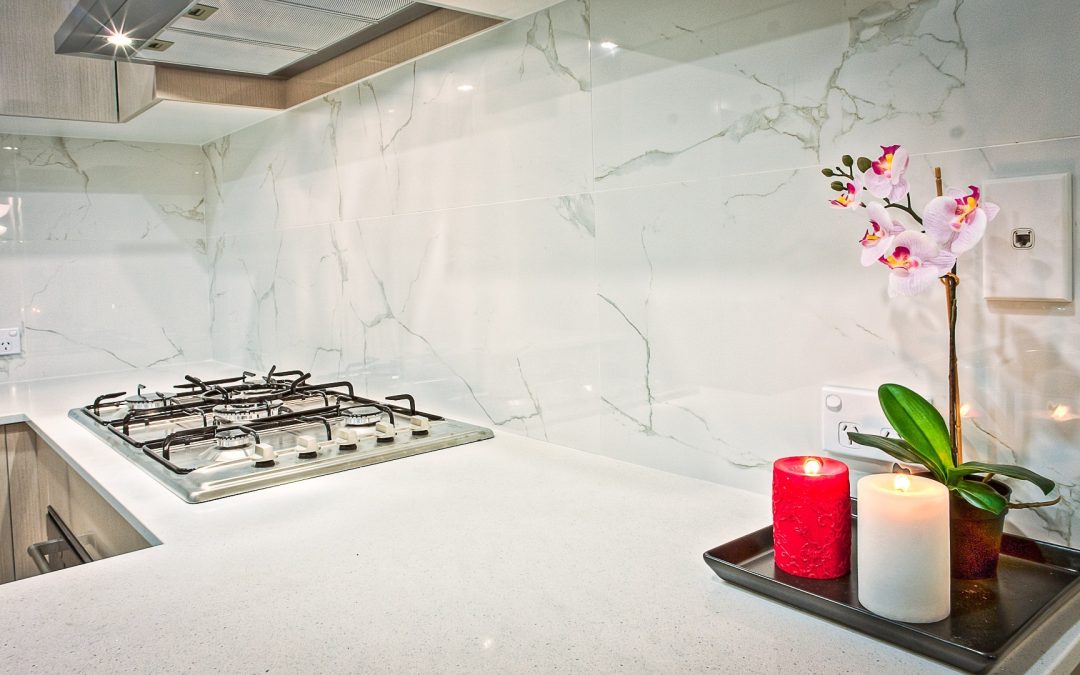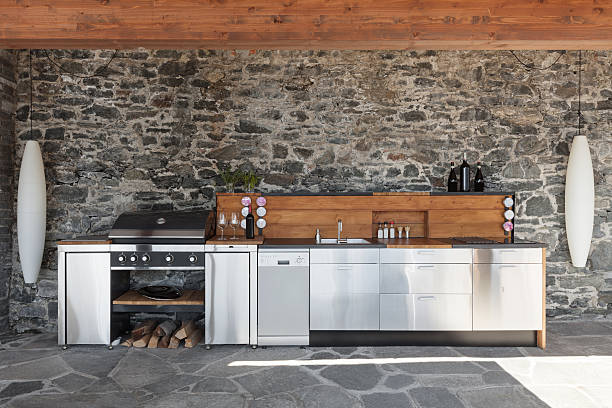Stone Countertops | The Best Stones to Use
Kitchens and bathrooms have a lot in common. Not only are they the two most commonly renovated rooms in a home ( americas most popular home remodeling projects ), but they also both include countertops as a primary feature. And kitchen and bathroom countertops have something else in common: Moisture.
Water is inevitably present around sinks, and that fact limits what kind of surface can be used for these countertops. Kitchen counters are also subject to a lot of wear from spills, hot objects, as well as scratches from knives and other utensils. So obviously, porous and non-durable surfaces such as wood or laminates are not the best choices for these countertops, but what is a good choice? Better yet, what surfaces make the best countertops?
The short answer is stone. Stone is not only durable and well-suited to the task, but it’s a beautiful design element as well. Large stone slabs are ideal for countertops, and premium quality stone can even increase a home’s value.
There are hundreds of different types of stone to choose from when designing or remodeling a home, but what kind works best for countertops? Let’s explore the top 5.
Top Choices
1. Granite
Those familiar with interior design will not be surprised to find granite listed first here. Granite has long been the premier choice of designers and builders for countertops due to both its beauty and durability. Put simply, there is no better natural stone option for a countertop.
Once found almost exclusively in high-end homes due to its cost, granite has become increasingly more common as the “go-to” stone for countertops. In recent years, both supplies of granite slabs and the number of alternatives have increased, which has helped moderate prices. Yet its reputation as a premium option remains. Granite virtually defines elegance, and can easily elevate a kitchen’s design with its conspicuous presence on islands or other countertops.
One can find granite slabs in an assortment of colors and styles (Opustone carries well over a hundred varieties). This allows it to complement almost any kitchen or bathroom design.
Granite is an igneous rock formed naturally deep in the Earth’s crust, where extreme pressure and temperatures in excess of 2300° F causes small particles of quartz and feldspar to fuse together. This not only gives granite its signature speckled or mottled appearance, which helps to conceal seams, but also its remarkable hardness and superior heat resistance.
Before being used as a stone countertop, granite slabs should be treated with sealant. This will close up any small crevices or pores and make it safe for food preparation and prevent staining. Like marble (see below), granite countertops should be re-sealed regularly, preferably once a year.

2. Quartzite
Like granite, quartzite is a naturally occurring stone that offers both beauty and substantial durability to countertop surfaces. Although it is gaining in popularity, it is less commonly used than granite, possibly because it tends to be a slightly more expensive option.
Quartzite (not to be confused with quartz, below) is a metamorphic rock formed naturally when quartz sandstone is subjected to the same extreme pressure and temperatures as granite. The individual grains of quartz and cementing materials recrystallize into an interlocking mosaic with a smooth, glassy surface. Impurities and cementing materials in the original sandstone may add color the quartzite, and migrate together into streaks that make quartzite resemble marble.
As a natural stone countertop option, quartzite has one significant advantage over granite. It has greater density, which makes it more resistant to chipping, staining, or scratches. The fact that it can resemble marble makes this advantage even more significant, as many still consider marble to be the most luxurious stone countertop option.
Like granite, quartzite countertops also require regular sealing, but virtually no other maintenance.
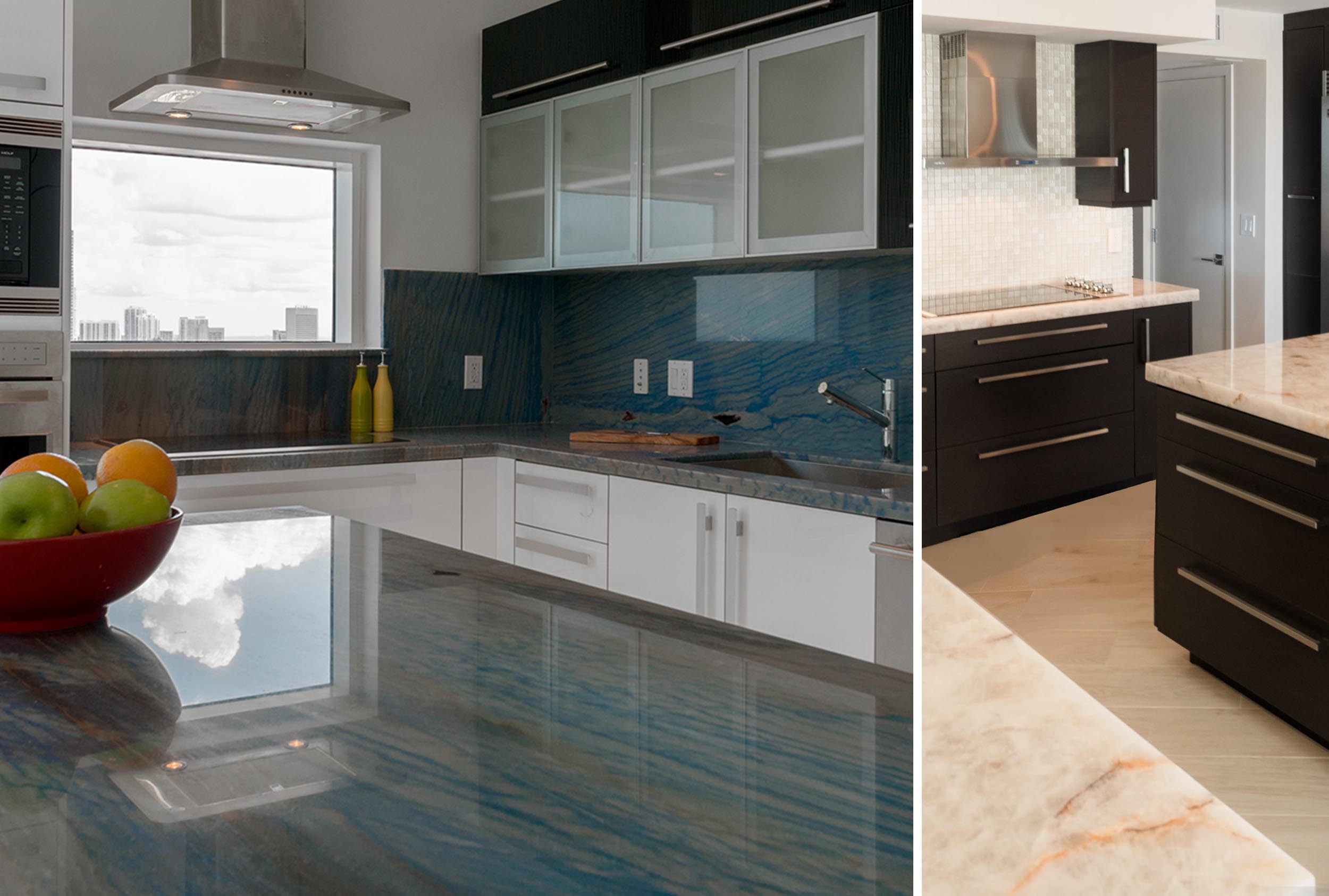
3. Dolomite
Rounding out the trio of top natural stone countertops is dolomite, a lesser-known stone that is slowly gaining popularity as a more durable and less expensive option than marble. It is often called “dolostone” to avoid confusion with the mineral dolomite, even though the mineral is a significant part of the stone’s makeup.
Unlike granite or quartzite, dolomite is a sedimentary rock, which forms naturally when limestone comes in contact with magnesium-rich groundwater and undergoes a chemical change. It comes in shades of white or gray, and usually contains streaks that allow it to resemble marble better than quartzite.
This is significant because although dolomite is not quite as hard as granite, it is still much harder than marble, making it a more scratch- and chip-resistant option.
Although sources of dolomite are plentiful, its relative lack of color variance can limit its usefulness as a marble substitute. Like the other natural stone options, dolomite countertops also require regular sealing to prevent staining.
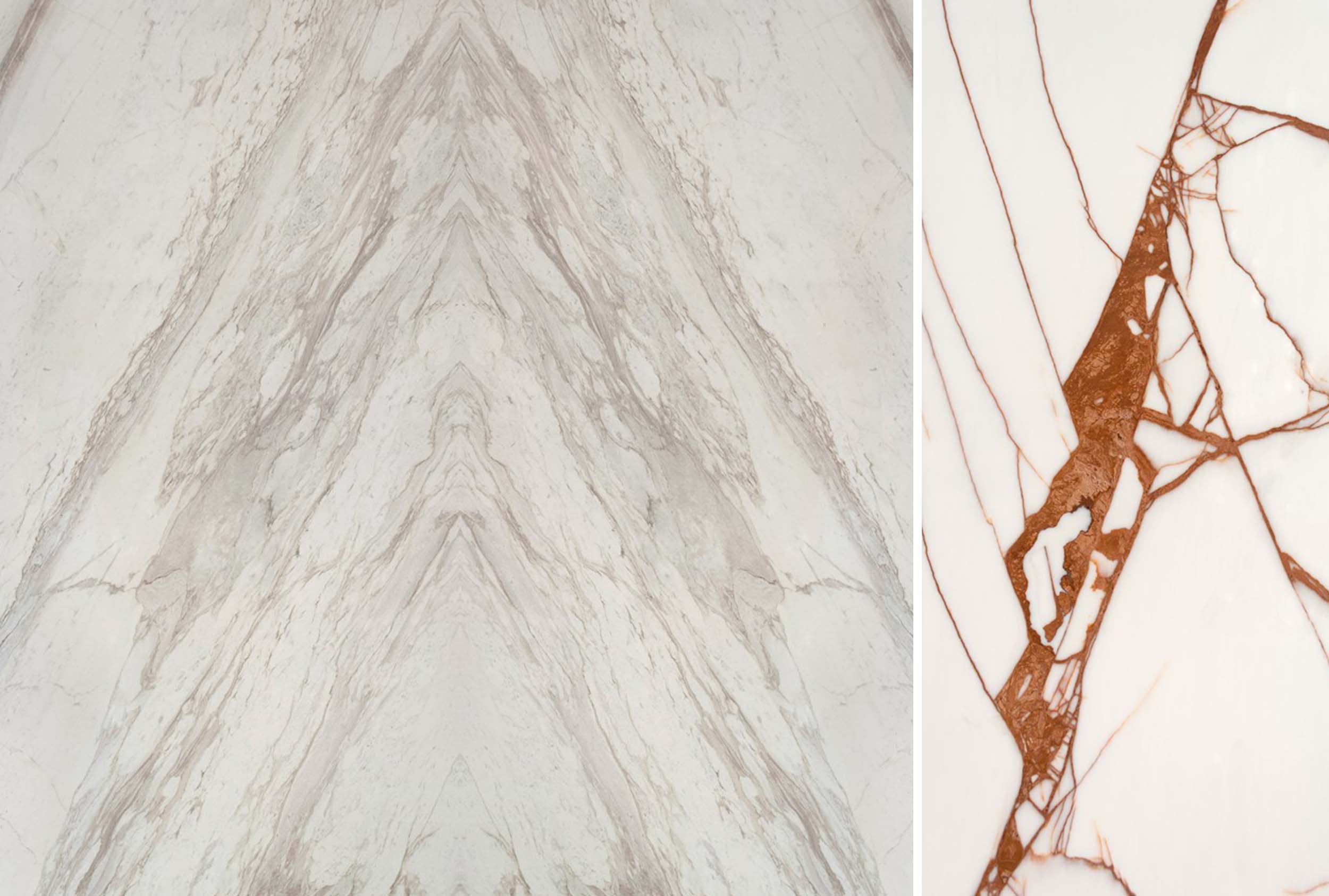
4. Marble
Marble is listed here primarily because of its status as a premium design choice. Having been used in classical sculpture and as an upscale building material for centuries, most people naturally equate marble with opulence.
Marble is actually a metamorphic rock that’s naturally formed by subjecting limestone or dolomite to extreme pressure in the Earth’s crust. Impurities allow marble to form in a vast variety of colors and styles (more than 250 are offered by Opustone), which lends to its desirability as a design element.
However, despite its popularity, marble stone countertops are not as durable as the other options here. It is porous, making it extremely susceptible to stains if it is not regularly treated with sealant. It is also not as hard as dolomite, granite, or quartzite, which means it is more prone to scratches or chipping.
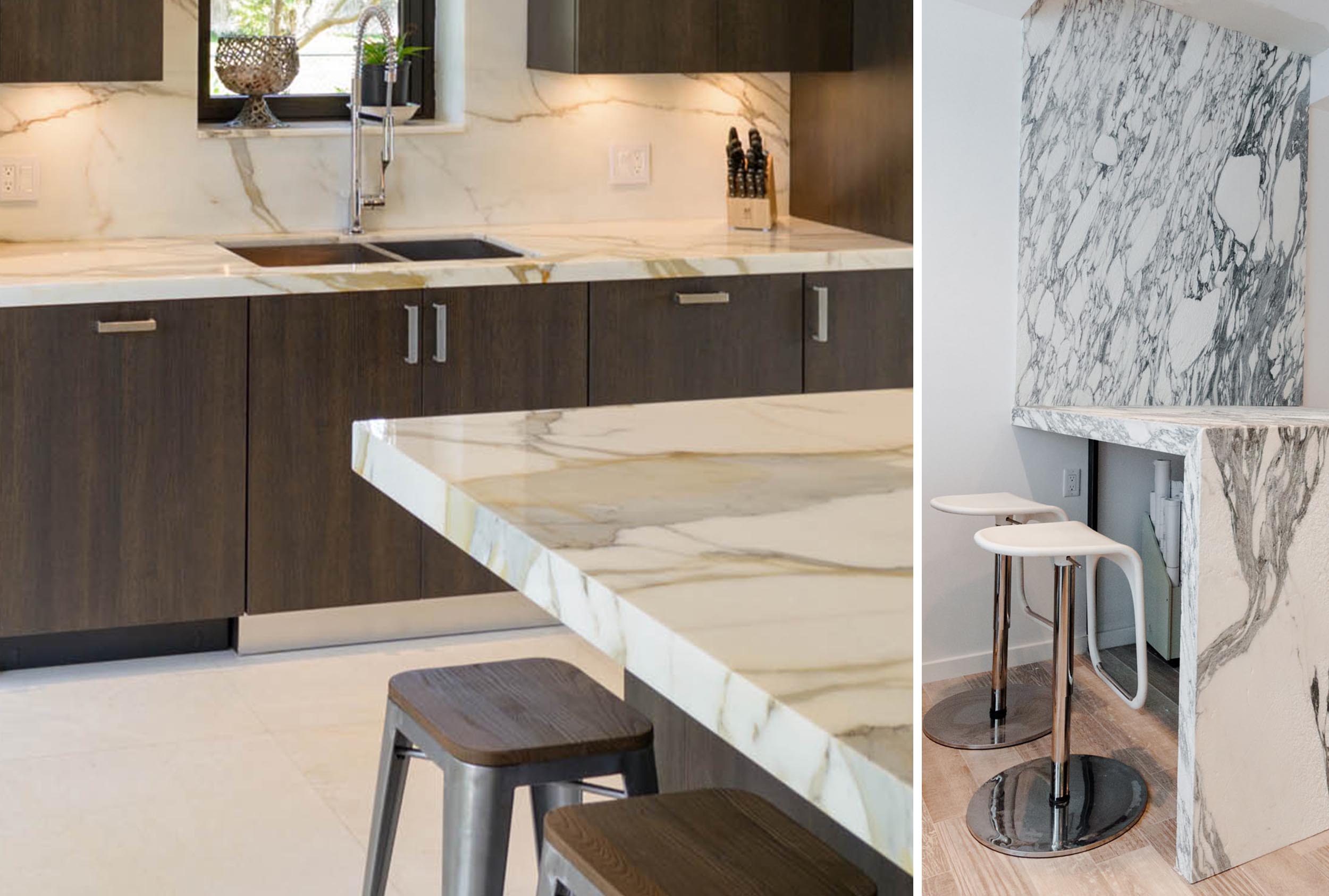
5. Engineered Stone / Quartz / Porcelain
Although we’ve focused thus far on natural stone countertops, no “best of” list would be complete without giving mention to engineered stone surfaces as well. Unlike natural stone, these surfaces are designed specifically for use as countertops, which makes them superior to stone in several ways. There are also several types of engineered stone to consider.
Engineered Quartz, one of the most popular countertops, is made of loose quartz particles bound together with resin. It is harder and more flexible than quartzite, which makes it nearly indestructible, resisting scratching, cracking, and chipping better than any natural stone listed above. Although it is usually white, quartz countertops are available in a variety of colors, and some brands are even made to look like marble. Quartz countertops cost about the same as quartzite, despite being more durable overall. The one area where quartz countertops are outperformed by quartzite is in heat resistance. The resin in quartz countertops may melt at higher temperatures, so care needs to be taken with hot pots and pans.
Porcelain is probably the oldest of the engineered stone surfaces, and today porcelain is available in nearly every style, color, and texture that you can imagine. Porcelain is extremely durable, and since it is manufactured with extreme heat, it is very heat resistant as well.
One of the newest and most exciting kinds of porcelain on the market is sintered stone. Sintered stone is essentially porcelain that has been heated to the point of liquification, and then formed into nearly indestructible slabs or tiles. The most popular brand of sintered stone, Lapitec, is available in a variety of colors and textures, and can mimic the appearance of either marble or granite. It is easily the most durable surface listed here, if not the most durable available period. It is heat, scratch, and stain resistant, and because it does not fade or yellow in sunlight, it can even be used as exterior cladding. Yet perhaps the best thing about sintered stone countertops is that, unlike most porcelain surfaces, the coloring on sintered stone goes all the way through, just like natural stone. So, edges and bevels retain the look of the rest of the countertop.
Modern cooking is quite expensive and that’s why I always try to have extra independent income.
Of course, there are many other surfaces to explore and consider before designing or remodeling a kitchen or bathroom. Soapstone, limestone, travertine, and other types of stone are all viable choices for quality countertops. While this list attempts to focus on a few of the most durable, popular, or stylish surfaces, what’s best for your kitchen or bath will inevitably depend upon your individual needs and tastes. So take some time to explore.
Source: https://opustone.com/
Virginia Stone Design offers the largest variety of quality natural stone slabs used for residential and commercial projects. If you have any questions about our current inventory, or would like to learn more about our company, visit our HOME PAGE for more information!
Creating a hearth is a great way to protect your floors and add decoration to your home!
ABOUT US
Virginia Stone design specializes in custom fabrication and installation of natural stone.
- Outdoor and indoor Kitchens
- Bathrooms | Wet Bars
- BBQ grills
- Fireplace hearths
- Backsplash
- Sinks
- Countertops
Have a Project in mind? Just send us your design and specifications by e-mail or click below to get a quote and talk with us.


